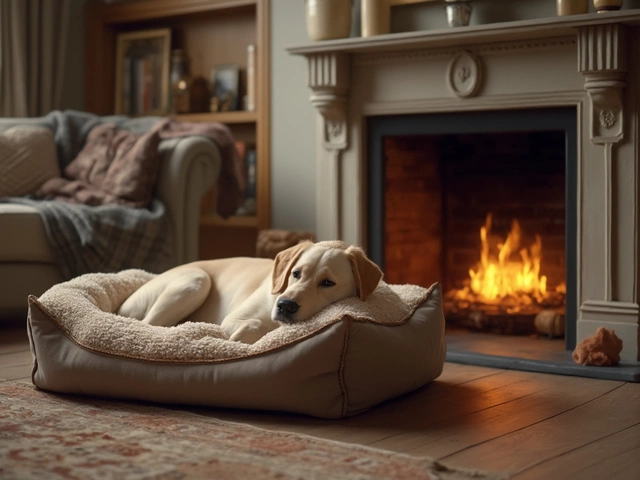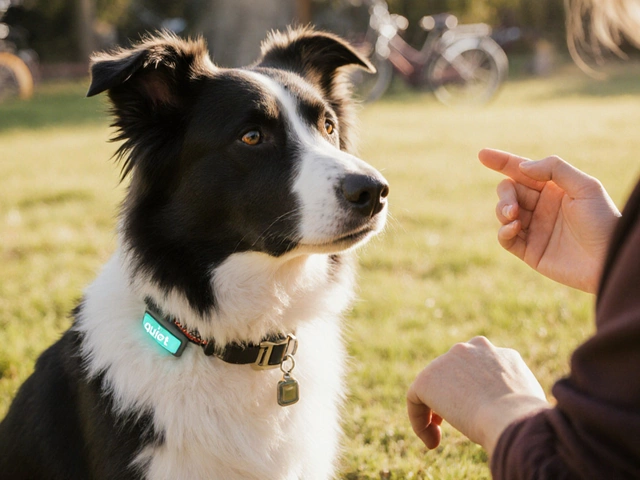Ever tried to pick out a collar for your dog and felt lost in the sea of options? If you landed on breakaway collars and wondered what else is out there, you’re not alone. Breakaway collars are designed to pop open under pressure, so dogs don't get stuck and choke. But sometimes, you need something with a bit more control—maybe for walks, training, or active dogs that love to tug.
The good news? There are solid alternatives. From classic flat buckles to no-slip martingales and quick-release styles, each type does something a little different. Knowing what your dog really needs can save you money, hassle, and even keep your pup safer than you expected. Let’s break down what these options offer, where they shine, and how to choose what really fits your furry friend’s lifestyle.
- Why Do People Choose Breakaway Collars?
- The Main Alternatives: Pros and Cons
- How to Pick the Right Collar for Your Dog
- Tips for Safe Everyday Use
Why Do People Choose Breakaway Collars?
Breakaway collars might sound fancy, but at the end of the day, they do one job really well: keeping your dog from getting caught and hurt. The main reason people grab a breakaway collar is safety, especially for pets that spend time outside or around objects that could snag a collar—like fences, crates, or even other animals during play.
Here's the real deal: a trapped collar can quickly become a choking hazard. The Humane Society has flagged accidental strangulation as a risk, especially for active and outdoor dogs. A breakaway collar pops open when pulled with moderate force, letting the dog slip free fast. Some owners, especially those with energetic or curious dogs, say it’s a lifesaver.
- Breakaway collar is a top pick for dogs left alone in the yard or home, and also for adventurous cats.
- It’s big for folks worried about their pet getting hung up on a branch, stick, or even another dog’s teeth during rough play.
- It’s a basic safety net for dogs too smart for their own good, who slip into tight gaps or wiggle behind furniture.
To give you a quick look at why many grab this style, check out this handy table showing common scenarios and risks:
| Situation | Risk Without Breakaway | How Breakaway Helps |
|---|---|---|
| Dog home alone in crate | Collar snags on bars, choking or panic | Collar opens, dog is free |
| Playing in backyard | Snag on fence, bush, deck, or branch | Quick release prevents harm |
| Multiple dogs roughhousing | Jaws or paws get caught in collar | Collar opens during tangle |
This isn’t just about being extra careful. According to a 2022 survey from Pet Poison Helpline, over 3,000 collar-related injuries or close calls get reported in U.S. vet clinics every year. So, if you’re nervous your dog will get into trouble, a breakaway collar might seem like common sense.
The Main Alternatives: Pros and Cons
Every dog and every owner has their preferences. Not all collars are built equal, and each type brings something different to the table, especially when you’re moving away from a breakaway collar. Let’s look at the main contenders and what you should expect from each.
- Flat Buckle Collars: These are the standard dog collars you see everywhere. They have a simple buckle or snap and hold up for daily walks and tags. Their big plus is reliability—they don’t pop off unless you take them off. But that’s also their flaw: if your dog gets snagged, the collar stays put, which can be risky if your dog loves squeezing through fences or under things.
- Martingale Collars: Think of these as collars with a built-in safety net. They tighten slightly if your dog pulls or tries slipping out but won’t choke if fitted right. Many trainers recommend martingales for breeds with necks wider than their heads, like Greyhounds. They’re great if you want a little more control but don’t want to risk your dog backing out of a flat collar.
- Quick-Release Buckle Collars: Similar to flat collars, but with a plastic or metal buckle that’s easy to open with one hand. They’re handy if you need to remove the collar quickly, but they don’t break away on their own. Good for everyday use and quick removal, but, like flat collars, they don’t help if a dog gets caught.
- Harnesses: Technically not a collar, but loads of folks switch to harnesses, especially for small dogs or big pullers. They take pressure off the neck and can be safer if your dog is always on leash. Some harnesses have front clips for better control. Downside? Not ideal for dogs that wear ID on a collar 24/7 or those who hate the extra gear.
| Collar Type | Best For | Key Advantage | Important Drawback |
|---|---|---|---|
| Flat Buckle | Everyday wear, IDs | Reliable, won't fall off | No safety release |
| Martingale | Slippery heads, mild control | Prevents slipping out | Needs to be fitted right |
| Quick-Release | Easy on/off, puppy parents | Fast removal | No breakaway function |
| Harness | Training, pullers | Reduces neck strain | No collar for tags |
According to the American Kennel Club, “No single collar works perfectly for every dog. Owners should try a few and see what meets their dog’s needs for safety and comfort.”
The right collar makes walks safer and more enjoyable. Don’t be afraid to swap styles until you find the perfect fit for your dog’s energy and habits. — American Kennel Club
When choosing an alternative, keep your dog’s personality, habits, and escape artist skills in mind. Sometimes, the best option isn’t the fanciest—it’s just the one that works.

How to Pick the Right Collar for Your Dog
Narrowing down the best collar for your dog isn’t just about looks—it’s really about matching your dog’s habits and safety needs. Dogs come in all shapes and personalities, so what works for a calm house dog might not cut it for an active escape artist.
First, think about your dog’s size and strength. Big breeds like Labs or German Shepherds pull way harder than a little Shih Tzu, so flimsy clasps or thin fabric won’t hold up. Martingale collars are popular for dogs with narrow heads (think Greyhounds or Whippets) since these pups can slip out of regular collars. The martingale tightens if they pull, but it doesn’t choke—helpful if your buddy is a bit of a Houdini.
If your dog is mostly inside and doesn’t walk on-leash much, a plain flat buckle collar or a quick-release option could do the job. Quick-release collars snap open easily in emergencies, so you get extra peace of mind that your dog won’t get caught on something at home. Look for one that fits snug but not tight—slip two fingers between the collar and your dog’s neck, and you’re good.
Now, some dogs just love to tug, twist, and jump. For these pups, traditional breakaway collar types usually aren’t enough by themselves. Combine a flat collar or martingale for ID tags with a fitted harness for walks. This way, they stay safe at home and secure on your adventures.
Here’s the quick checklist for picking the right type:
- Weigh your dog and get their neck size—no guessing!
- Decide where your dog will wear the collar most (home, walks, dog park, training).
- If your dog pulls or slips collars, check out a martingale or a secure harness.
- For at-home wearers, consider a quick-release buckle for safety.
- Test the fit: snug, but slides two fingers under easily.
One last tip: always check the collar hardware every few weeks. Look for signs of wear, fraying, or a loose buckle. Replacing a worn collar is way easier than chasing a runaway dog.
Tips for Safe Everyday Use
No matter what collar you pick, it’s all about using it right. Even if your collar isn’t a breakaway collar, smart habits make the real difference. Let’s talk about some proven ways to keep your dog safe, comfy, and happy during daily wear.
First thing—get the fit right. A collar shouldn’t be too tight or too loose. If you can slip two fingers under the collar easily but it doesn’t slide over your dog’s head, you’re golden. Dogs outgrow or lose weight faster than you’d expect, so check the fit every few weeks. A 2021 study in the "Journal of Veterinary Behavior" found that more than 30% of collar-related injuries came from poor fit—either too tight or way too loose.
Here’s a solid routine to keep in mind:
- Check for wear or tears weekly—frayed stitching and stretched holes mean it’s time for a new collar.
- Clean your dog’s collar once a month, especially after hikes or beach trips. Dirt and salt can break down materials faster than you think.
- Never leave collars on unsupervised puppies, as they wrestle and chew on everything. Vets see tons of young dogs getting stuck or tangled.
- Use ID tags with your phone number. More than 80% of lost dogs that wear readable tags are reunited with their families, according to the American Humane Association.
- If your dog’s a Houdini and can slip any collar, consider a martingale or double-check for adjustments after every walk.
“Daily collar checks might feel small, but they can prevent big vet bills and emergencies. It’s one minute that could save you a lot of heartache.” — Dr. Jessica Barnett, DVM, North Shore Animal Clinic
| Collar Issue | How Common | What to Do |
|---|---|---|
| Poor Fit | Nearly 1 in 3 dogs | Re-measure every month |
| Frayed Material | Seen in 20% after 1 year | Replace collar right away |
| ID Tag Missing | Found in 15% of lost dogs | Use sturdy split rings |
The bottom line? Choose the right collar, check in on it often, and don’t skip the little stuff. It keeps your dog safe and saves you from future stress. If something looks off, swap it out—collars are cheap, vet emergencies are not.







